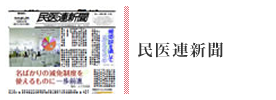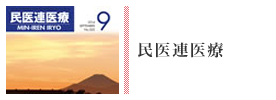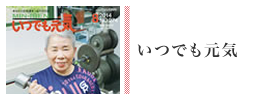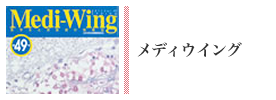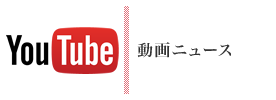english
2006年6月2日
Health Insurance Card Alone Will No Longer Assure Health Care: Elderly People’s Self-Pay Burden will be Doubled or Even Tripled!
What is the aim of the proposed mal-revision of the health care system, which would make the self-pay burden of the elderly people twice or even three times more? Assistant Secretary General Ainoya Yasutaka of the Central Council for Promotion of Social Security (Board member of Min-Iren) explains:
Q: What is the main point of the proposed “Outline of the Reform of the Health Care System”?
Ainoya: Besides the increase in the burden of senior citizens, the biggest problem is the “review on the content and scope of public insurance payment” and the planned opening of the market to private sectors. In other words, the health care system in Japan will be changed into one under which the people subscribing only to the public health insurance cannot receive necessary medical care to treat their illness. By narrowing down the scope of treatment and medication to be covered by the national health insurance, the government is attempting to cut down the public spending and force patients to shoulder the expenses for the parts not covered by the national health insurance system.
In the background of the move are the demands of the business circles and the U.S. corporations. Narrowing down the scope of public health insurance coverage would increase the burden of the patients, which in turn would please life and damage insurance companies that try to sell more insurance products for hospitalization or cancer treatment.
Medical Expenses in Japan are Low in the World
Ainoya: Our government claims, “Japanese medical expenses are high”, but is it true? According to the WHO’s international comparison of medical care system in 2000, Japan ranks first by the overall evaluation of health performance, and third by the equality. On the other hand, in terms of the ratio of medical expenses in the GDP, Japan ranks 18th. In other words, Japan has improved the health of the nation with low cost. It has been made possible by the national health insurance system, in which public health insurance subscribers can receive necessary medical care wherever they live, and by the dedicated efforts of the health care workers.
While the government talks much about curbing the “medical expenses”, it focuses only the “health insurance payment”. It is funded by the health insurance, except the part to be paid out-of-pocket by patients. The government is only trying to curb the expenses that affect the costs to be incurred by employers or the government.
However, suppressing the insurance payment will not help curb the overall medical expenses. As the society gets aged, necessary medical care would naturally increase. The Japanese government is launching new schemes, one after another, to impose on the people the burden of covering the gap between the natural increase of medical expenses and the suppressed payment from the public health insurance. This is the “medical care reform” aimed in the proposed “Outline”. It explains why the Ministry of Health, Labor and Welfare named it as “Structural Reform” of the health care system.
Additional Collection of Insurance Premium from the Elderly
Q: What are the specific contents of the “Outline”?
Ainoya: They are particularly harsh on older people. Old patients being hospitalized for a long time have to pay additionally for light, fuel and water expenses and cost for their meals. Estimated increase of their payment by them would be approx. 32,000 yen per month.
Now, persons over 70 years of age are required to pay 10% of the medical fee out-of-pocket, but in the new system, this would be increased to 20% until they reach 74 (starting in 2008). And the people over age 70 with the income “equivalent to those in active service” and now paying 20%, will have to pay 30% of the total medical cost (starting in October 2006).
Also, the government plans to set up in 2008 a “new health care scheme for the elderly”, by which anyone above 75 years old will have to pay the insurance premium. Even if they are nonworking dependents (family members), they will have to pay the premium when they reach 75. Their estimated premium payment is 72,000 yen on average per year (6,000 yen monthly).
Further, it is planned that the premium payment of the national health insurance of those between age 65 and 74 will be deducted from their pensions.
The government plans to establish such increases of burdens on the old people before the time when the baby-boomers, who will start retiring in 2007, will spend more medical expenses.
“Don’t Bring Them to the Hospital!”
Ainoya: Next, I would touch upon the issue of “Improving the home care of terminal care patients”. At present, 80% of the patients who die from illnesses will die in hospitals and the remaining 20% will die at home. The government wants to increase them up to 40%. So, if 20% more people die at home, not in the hospital, it is estimated that the health insurance payment will be reduced by 500 billion yen by 2025.
A section chief of the Ministry of Health, Labor and Welfare in a lecture meeting said, “The proper evaluation of the terminal care” means to “encourage the patients to die at home”, which would amount to say, “Don’t bring such patients to the hospital”.
Q: I see. Even the final moment of one’s life will be determined by one’s wealth…
Emphasis on “Disease Prevention”
Ainoya: Now, let us turn to the question of the “emphasis on the disease prevention”.
We must not forget the fact that the “reform” of the nursing care, in the name of “transforming the system into one to stress the disease prevention”, actually curtailed or cut back on the services provided to the elderly in need of mild nursing care. If the government is really serious about disease prevention, patients’ out-of-pocket expenses, which have been raised every time the government revised the medical care system, should be restored to the pre-revision level. Due to the successive cutback on the social security system, many patients have lowered the level of their daily meals or take only two meals a day, instead of three. People’s health has been undermined by these mal-revisions of the social security system, and more and more people become potential patients of lifestyle-related diseases.
Lowering of Medical Treatment Fees
Ainoya: Fourthly, medical treatment fees will be lowered. The government has decided to lower the fees by 3.16%, the biggest ever rate of reduction, which should result in the curtailment of the total medical spending by approximately 1 trillion yen. It would accelerate further personnel reduction and lowering of wages of medical workers, intensify their workload, and threaten the very “establishment of secure and reliable medical care” envisaged by the “Outline”.
Possible Introduction of “Deductible System”
Ainoya: Though not included in the “Outline”, a “Deductible System” has been proposed by private sector representatives in the Economic and Treasury Advisory Council, which we should watch out carefully.
This “Deductible System” will exempt certain amount of medical payment from the coverage of health insurance. In the current system, if the total medical treatment fee for a patient is 5,000 yen, a current health insurance subscriber whose out-of-pocket expense should be 30% will be required to pay 1,500 yen at the hospital cashier. Suppose the deduction is set at 1,000 yen in the possible new system. Out of the total fee of 5,000 yen, the patient must pay out-of-pocket 1,000 yen that is not covered by the insurance, plus 30% of the remaining 4,000 yen. The total out-of-pocket payment will be 2,200 yen, which would amount to more than 40% of the total medical fee.
We Must Call into Question the “Structural Reform”
Q: What should we do now?
Ainoya: We need to achieve a genuine reform in the medical system, which would defend the right of the people to life. The fundamental principle of securing governmental fund for necessary medical expenses of the people should be established.
In the name of the “Structural Reform” or “transferring the governmental works to private sectors”, the government is devolving various responsibilities of the State on private sectors in a wholesale manner. They say, “the competition among private sectors will give rise to more efficiency and better quality”. But is it really true? Are last year’s tragic train wreck accident of the Japan Railway-West and the recent cases of fraudulent earthquake-resistance inspection not the result of such belief? What we are experiencing now are the worst consequences of the collapse of “safety and security” of the Japanese society.
If the medical care system is engulfed in the ongoing “Structural Reform” promoted by the government, the safety and security of people’s lives will be lost. We need to question the content of the so-called “Structural Reform” and raise our voices of opposition. Today, more and more people are feeding distrust toward the government as the security of their medical care, foods, jobs and housing is threatened. We must stop the high-handed activities of big businesses and financial circles, and work to form a grand consensus among the people to recover the security and stability of people’s living.
 この記事を見た人はこんな記事も見ています。
この記事を見た人はこんな記事も見ています。




